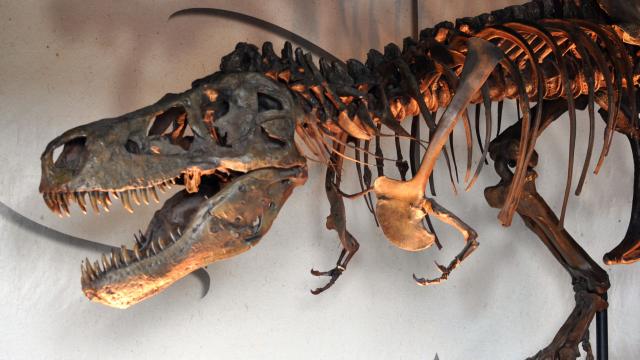Tyrannosaurus rex was among the most fearsome carnivores to have ever lived, but this killer still had to endure an adolescent phase. Far from being awkward, however, these teenage titans managed to pack a tremendous punch prior to maturing into full-sized adults, as new research describes.
Unlike their lumbering yet undeniably powerful parents, teenage T. rex were fast and agile, equipped with teeth that were good for cutting, not crushing. These juveniles were able to hold their own in a perilous Cretaceous world, before entering into a growth spurt that brought them into adulthood and a new way of life.
Such are the findings of new research published in Scientific Reports, in which paleontologists analysed a pair of mid-sized T. rex skeletons found during the early 2000s. Known as “Jane” and “Petey,” these fossils were unearthed in Carter County, Montana by paleontologists from the Burpee Museum of Natural History in Rockford, Illinois.
Jane and Petey were roughly half the size of an adult T. rex, which could grow to 12 meters (40 feet) in length. Fully mature T. rex—with their 1.5-metre-long (5-foot) heads—were basically gigantic chomping machines who used their powerful jaws to crush prey. Needless to say, this impressive bone-snapping ability, at an estimated 8,000 pounds of force, didn’t appear until later in life. The new research is important because it shows how juvenile T. rexes survived before they developed this capacity.
Importantly, the new research could also settle a debate caused by the discovery of Jane, Petey, and other apparently mid-sized T. rex skeletons. Some paleontologists argued that these fossils didn’t belong to T. rex, but rather a pygmy genus of tyrannosaurid, which they dubbed Nanotyrannus. The evidence presented in the new paper, led by Holly Woodward from the Department of Anatomy and Cell Biology at the Oklahoma State University Centre for Health Sciences, likely represents the death knell for the Nanotyrannus theory, which, to be fair, is a fringe theory to begin with.
The reason for this uncertainty and the ongoing debate, however, can be traced to the lack of juvenile dinosaur specimens.
“Historically, many museums would collect the biggest, most impressive fossils of a dinosaur species for display and ignore the others,” said Woodward in a press release. “The problem is that those smaller fossils may be from younger animals. So, for a long while we’ve had large gaps in our understanding of how dinosaurs grew up, and T. rex is no exception.”
Using a technique known as paleohistology, Woodward and her colleagues studied the microscopic structures embedded within the fossilized bones. Analysis of thin slices taken from the femur and tibia conveyed the specimens’ age, growth rate, and level of maturity.
“To me, it’s always amazing to find that if you have something like a huge fossilized dinosaur bone, it’s fossilized on the microscopic level as well,” said Woodward. “And by comparing these fossilized microstructures to similar features found in modern bone, we know they provide clues to metabolism, growth rate, and age.”
Results of the analysis showed that Jane and Petey were around 13 to 15 years old when they died, which means they had yet to experience their pre-adult growth spurt; T. rexes reached maturity at around 20 years of age, but they didn’t live much beyond 30.
The new research also showed that T. rex exhibited rapid growth rates similar to modern birds and mammals, but their rate of growth was regulated by the availability of food. Variability in their growth, as evidenced by spacings the “growth rings” of their bones, suggests they grew quickly when food was in abundance and slowly when food was scarce.
“This study helps us understand how T. rex went from a tiny baby to enormous adult,” Steven Brusatte, a University of Edinburgh paleontologist not involved with the study, told Gizmodo in an email. “Not only did they grow super fast, but they could change their growth rates depending on how much food and resources were available. This flexibility helped T. rex so utterly dominate its ecosystem.”
And finally, the new research also shows that these pint-sized T. rexes were still a force to be reckoned with. They were “sleek, slender, and fleet-footed” and had “wonderful knife-like teeth,” said study co-author Scott Williams from the Museum of the Rockies in a press release. The new research suggests “these animals probably dominated their ecosystems at all ages,” he said.
Standing a bit taller than a large horse and measuring around 20 feet in length, teenage T. rexes must’ve terrorised the Cretaceous landscape. It seems fitting that this iconic dinosaur, even before reaching full maturity, was already plenty deadly.
